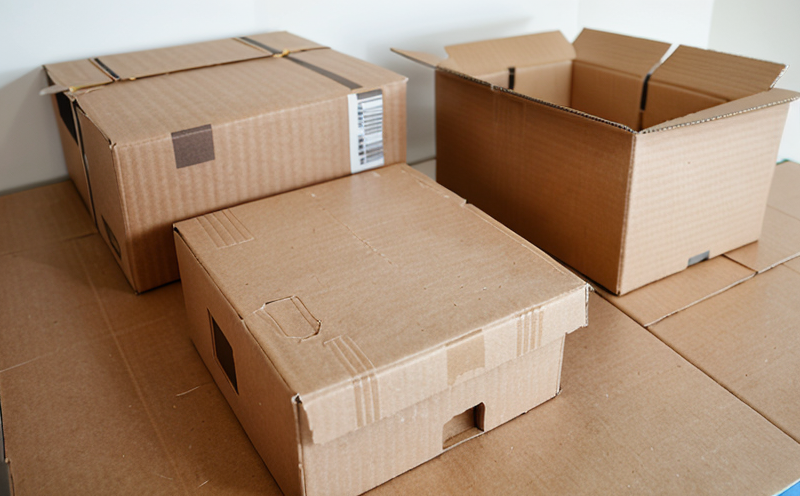ISO 534-2 Caliper and Thickness Uniformity Testing
The ISO 534 series of standards provides a framework for evaluating paper and board materials. Specifically, ISO 534-2 focuses on the caliper and thickness uniformity testing methods which are crucial in ensuring that packaging meets quality specifications. Caliper refers to the measurement of the thickness of the material at various points while maintaining a consistent width. Thickness uniformity ensures that there is no significant variation in the thickness across the entire piece of material, which can affect its performance during use.
Caliper and thickness measurements are essential for packaging materials because they influence how well the package holds its shape under pressure or stress, as well as its ability to withstand moisture. For instance, if a cardboard box has uneven caliper, it may not close properly, leading to potential leaks or damage during transportation.
The process begins with selecting representative samples of the packaging material according to ISO 534-2 guidelines. These samples should be cut into strips that are approximately 10 cm long and about half an inch wide. The strips are then placed in a suitable fixture, ensuring they are aligned properly for accurate measurement.
The caliper is determined using a micrometer or other precision measuring devices designed to measure thickness at multiple points along the strip. For each sample, measurements should be taken from both ends towards the center, creating an average value that represents the overall caliper of the material.
Thickness uniformity involves comparing these individual measurements across all samples within one batch. A common acceptance criterion for this test is that no more than 10% of readings can differ by more than a specified tolerance level (typically ±15%) from the average value. This ensures that each piece of packaging will perform consistently, contributing to product safety and customer satisfaction.
Accurate caliper and thickness uniformity testing helps manufacturers ensure compliance with international standards such as ISO 534-2. It also supports research and development efforts by providing precise data about material properties, enabling improvements in design or formulation if necessary.
Testing results are typically reported graphically showing variations in caliper across the sample length and statistically summarizing thickness uniformity metrics like standard deviation and coefficient of variation. Such information is invaluable for quality control departments when evaluating batch consistency and identifying potential issues early on.
Eurolab Advantages
At Eurolab, we pride ourselves on offering top-tier packaging testing services tailored specifically to meet the needs of our clients across various industries. Our state-of-the-art facilities are equipped with advanced instrumentation capable of delivering highly accurate caliper and thickness uniformity measurements that adhere strictly to ISO 534-2 standards.
We employ highly trained professionals who understand both the technical aspects of these tests as well as their broader implications for packaging performance. By working closely with you during every step of the process—from sample preparation through final analysis—we aim to provide reliable insights into your materials' characteristics.
Our commitment doesn't end there; we also offer comprehensive support throughout all stages of testing, including interpretation of results and recommendations based on findings. Whether you're looking to improve current products or develop new ones compliant with international regulations, Eurolab is here to help you achieve your goals efficiently and effectively.
Why Choose This Test
Paper and cardboard packaging play a critical role in protecting contents during shipping and handling processes. Ensuring that these materials meet specific quality standards is essential for maintaining brand integrity and customer satisfaction. By incorporating ISO 534-2 caliper and thickness uniformity testing into your quality assurance program, you can:
- Ensure consistent performance across all units produced,
- Detect defects early in the manufacturing process before they become costly problems,
- Meet regulatory requirements set forth by international standards bodies,
- Show commitment to sustainability initiatives by using materials that perform reliably under expected conditions.
In addition, this type of testing allows for continuous improvement through regular audits and updates to production methods based on test results. It fosters an environment where innovation can thrive while still adhering to stringent quality expectations.
Quality and Reliability Assurance
- Precision Measurement: Our laboratories use high-precision instruments that adhere strictly to ISO 534-2 specifications. This ensures accurate caliper readings down to the micrometer level, providing reliable data for decision-making.
- Consistent Results: By replicating tests under controlled conditions, we guarantee consistent results across multiple batches of material, allowing you to compare different versions easily and make informed choices.
- Closed-Loop System: We maintain a closed-loop system where feedback from testing directly influences manufacturing processes. This iterative approach ensures continual improvement over time.
These factors combined contribute significantly towards achieving high levels of quality assurance and reliability in paper and cardboard packaging products.





